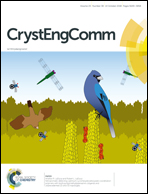Incorporation of hexacyanidoferrate(iii) ion in photoluminescent trimetallic Eu(3-pyridone)[Co1−xFex(CN)6] chains exhibiting tunable visible light absorption and emission properties†
Abstract
Hexacyanidometallates of CoIII and FeIII were combined with photoluminescent EuIII(3-pyridone) complexes resulting in a series of crystalline materials built of trimetallic cyanido-bridged chains, [Eu(3-pyridone)2(H2O)4][Co1−xFex(CN)6]·H2O (x = 0, 0.03, 0.06, 0.09, 0.12, 0.15, 0.25, 0.5, 0.75, 1; compounds 1, 2, …, 9, 10). They are isostructural, revealing a Eu–Co/Fe zigzag coordination chain topology, with a statistical arrangement of Co and Fe sites occupying the same crystallographic position of the bridging [MIII(CN)6]3− moiety. Replacement of CoIII with slightly larger FeIII going from 1 to 10 leads to the gradual expansion of the unit cell caused mainly by the elongation of the lattice constant c related to the alignment of coordination chains. The unit cell parameters depend linearly on the Fe fraction, obeying Vegard's law; thus, 1–10 can be considered as molecular substitutional alloys based on the formation of a Co/Fe solid solution within the flexible coordination network. The variation of the Co/Fe ratio governs the optical properties, leading to tunable absorption and emission characteristics from red emissive, weakly coloured 1–2 to weaker emissive, red coloured 8–10. Fe-free compound 1 is colourless, while the addition of Fe in 2–10 induces an orange to red colour related to the absorption at ca. 420 nm of ligand-to-metal charge transfer (LMCT) origin. Upon UV light excitation, Fe-free compound 1 shows significant room temperature EuIII-centered red emission, enhanced by the energy transfer from [CoIII(CN)6]3− and 3-pyridone to EuIII centers. Red emission is detectable over the whole family of 1–10, also for the Co-free compound 10, indicating that the hexacyanidoferrate(III) ion can be applied as a molecular linker in the construction of lanthanide-based luminescent coordination frameworks. However, on increasing the Fe fraction, both the overall emission intensity and the emission quantum yield decrease exponentially accompanied by the gradual shortening of the emission lifetimes. This indicates that all the Eu–Co/Fe compounds absorb UV light similarly, but the Fe centers do not transfer the energy towards Eu(III) efficiently, which is related to the disturbing presence of LMCT and metal-centered ligand field excited states in the visible range.
![Graphical abstract: Incorporation of hexacyanidoferrate(iii) ion in photoluminescent trimetallic Eu(3-pyridone)[Co1−xFex(CN)6] chains exhibiting tunable visible light absorption and emission properties](/en/Image/Get?imageInfo.ImageType=GA&imageInfo.ImageIdentifier.ManuscriptID=C8CE01020J&imageInfo.ImageIdentifier.Year=2018)


 Please wait while we load your content...
Please wait while we load your content...